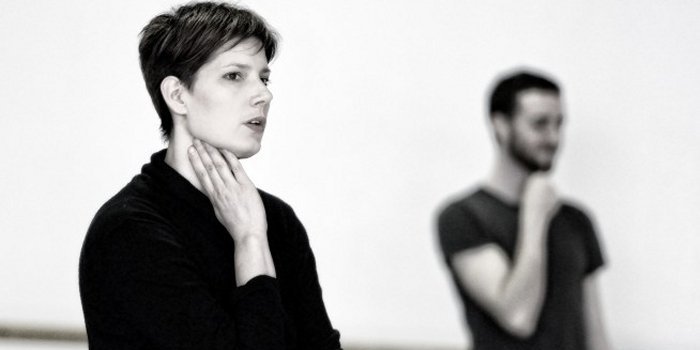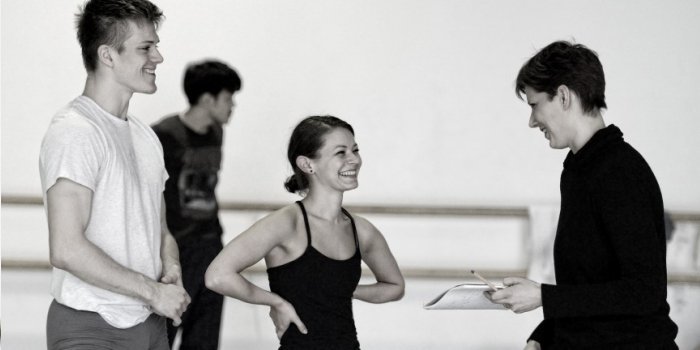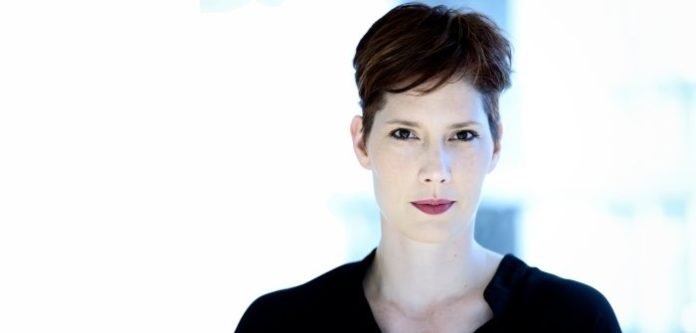At the age of five most young girls are just learning how to ride a bike, jump rope and hosting imaginary tea parties. For Ballet BC’s artistic director Emily Molnar though, she was already dreaming of being a dancer.
“I was a very energetic child and I think it was my grandmother that basically looked at my mother and said, ‘you’ve got to put her into some dance classes because she’s just roaming around the house and needs to put it somewhere,’” says Molnar by phone during a break from the studio.
Starting with a creative movement class at age five, Molnar would begin ballet classes a year later, and own her first pair of pointe shoes by age seven.
“I’ve been in the studio every day since then, and I’m not seven anymore,” she says with a laugh. “It’s almost 40 years in the making, so it’s been a passion of mine, dancing. As soon as I was in that studio, it felt like things just made sense. It felt like it was the world that I understood and belonged to me in a way, and so it really felt at home.”
As Molnar gets ready to celebrate ten years as artistic director of Ballet BC following the the closing performance of Program 3 on May 11, we had an opportunity to chat about her journey to the company’s top spot.
Off to school
A feeling of belonging in the world of dance would follow Molnar through her career, but it all began when she left her Regina home, alone, at just ten years of age to attend the National Ballet School of Canada (NBS) in Toronto.
“It’s very hard for me to imagine if I had a daughter, letting her go at ten. But when I was ten, it felt very different,” she says. “It really felt like the right thing to do. I knew I wanted to dance. It was very important to me. It was a calling without knowing at ten what a calling was.”
Describing herself as already “driven” at that age, Molnar knew that the NBS was the best place for her to develop professionally and build her understanding of dance.
“I wanted to be a classical ballet dancer first, so I knew that was where I would get the best training,” she says. “It felt like the right thing. I didn’t question it all.”
Not that leaving home at such a young age would be easy, for herself, her family, or for a brother she never really knew growing up.
“It was emotionally challenging being away from my family,” she says. “I had a brother who was born the exact same year that I left, so I’ve never lived with him.”
Still it all made sense to Molnar, driven by a need to dance.
“There was always this force inside of me that said, ‘you have to dance; this is what you’re meant to do,’ and it helped me get through times that might have been more difficult,” she continues. “I’ve always had to work for everything that I’ve ever done. It’s not come easily at all, but I don’t think I’m alone in that.”
“There was always this force inside of me that said, ‘you have to dance; this is what you’re meant to do’.”
A family’s support
Having the support from her parents helped, even when that support was not necessarily blind.
“My father was hesitant. He didn’t think dancing was a profession, and my mother understood it was, but was having a hard time seeing me go because of course I was ten, and that’s emotionally very tricky,” she says. “But they both realized that I wanted it so badly that they had to let me try.”
It also helped that Molnar came from an athletic family, including a father who played for the Saskatchewan Roughriders at the time. “They understood that drive towards the expression of the body.”
Rising fast
Acceptance into the NBS however did not automatically mean a dancer would continue until graduation. Instead, like the other students, Molnar found herself with the added pressure of having to audition for each subsequent year. It would perhaps be no surprise in knowing now that she even found herself elevated a grade, graduating at age sixteen.
“It went quite quickly and it was quite a wonderful and intensely invigorating process for me to be at the school.”
Molnar’s determination as a dancer while attending the NBS was never more evident than in a performance of Swan Lake for the school’s season finale when she fractured her baby toe the week before. After getting the go-ahead from a doctor, her toe was frozen every night before she went out to dance.
“There was something about the mystery of that moment and going through this kind of crazy pain of my foot and then going out there and having some of the most magical shows for that week that I’ve ever had,” she says. “And it wasn’t because I was on any kind of drug or anything.”

An early connection to Ballet BC
Molnar’s time at NBS would also see her first connection to Ballet BC.
“Ironically one of the first people I actually worked with choreographically as a contemporary artist was John Alleyne,” says Molnar. “He was starting to choreograph at the time and he was in the National Ballet of Canada as a dancer, and he came to the school and he created a work for us.”
It was in this moment, at twelve years old, where Molnar’s resolve as a dancer would solidify. “That was also a moment where I knew this is what I want to do, to work with a choreographer, to dance and make work of today using this training.”
For those not up on their Ballet BC history, Alleyne first joined the Vancouver company in the 1980s, choreographing a number of works. Appointed its artistic director in 1992, Molnar not only found herself working for him at Ballet BC, it be from his departure that Molnar would eventually take the company’s reins.
Working with William Forsythe
But before that could happen, Molnar first found herself as an apprentice at the National Ballet of Canada. It is there where she would meet one of her biggest influences, internationally renowned dancer and choreographer William Forsythe.
Recognizing Molnar’s talent, Forsythe was responsible for her getting contracted to the National Ballet for his now legendary work, The Second Detail.
“He’s one of our iconic choreographers,” she says. “He came into my life at sixteen as part of one of my first professional gigs. So, it is a pretty special memory.”
It would also be the beginning of a longer collaboration with Forsythe, as he returned to the National Ballet of Canada four years later to offer her a job with the Frankfurt Ballet. It would become Molnar’s home for the next five years.
Following her time at Frankfurt Ballet, Molnar found herself at a crossroads, even considering at one point to step away from dance to become an anthropologist.
“I’d been saturated with so much incredible information working with William Forsythe, but I felt like I had some questions about myself in the profession, not the profession itself,” she says.
The move back home
Eventually deciding to move back to Canada, Molnar didn’t hang up her dance shoes. Instead she found herself hired into the company by then artistic director John Alleyne.
“He knew me. I had been in a lot of his creations, so when I came back to Canada in 1998, I was offered a job at Ballet BC,” she says.
But even before the relationship she had developed with Alleyne brought her to Ballet BC, Molnar recalls having seen the company a number of times while she was at the National Ballet School. She would also work with Reid Anderson, another of Ballet BC’s artistic directors, while a student.
“I actually knew the company when I was a kid in my own development,” she says. “I had built this relationship with the company in many different ways … it’s been very helpful to have seen the company over the years.”
“I had built this relationship with the company in many different ways … it’s been very helpful to have seen the company over the years.”
But while Molnar would find herself at Ballet BC under Alleyne, it wasn’t an immediate shot to the role of artistic director after Alleyne departed. Instead, she decided to take a break from the company to work as an independent choreographer and dancer, building her own projects and those of others.
It would be seven years between returning as a member of the Ballet BC company and her own freelance work before Molnar found herself leading the organization. She was grateful for the in-between time, as it prepared her for eventually taking on the artistic director role.
“That was really helpful because in that period of time I applied for grants, I was going into various companies, working with orchestras, building new work, and gaining an understanding how it all works,” she says. “I was just learning a lot of different skills that I had not necessarily had the opportunity to do as a dancer in a company.”
The rise to the top at Ballet BC
Molnar’s rise to the top spot at Ballet BC though didn’t come because she sought it out. With Ballet BC going through some major changes, including bankruptcy protection at the time, Molnar was initially brought in because of her expertise.
“The company decided to do a lot of community discussions, internal discussions, and I was a person that they interviewed as someone who was in the community that had an international history in dance, and had previously danced with the company,” she explains.
As the conversations continued, coupled with Alleyne’s departure, the search began for a new artistic director. While not a role Molnar was actively seeking at the time, it soon became evident it fit her goals at the time.
“I’d always thought about directing, and I felt pretty strongly about not starting my own company,” she says. “I wanted to help a variety of different people or be behind supporting a variety of different choreographers and a group of dancers, and so it felt like Ballet BC was the right fit, but I never imagined that this was the way it was going to happen.”
The start as artistic director of Ballet BC
Landing the job as the company’s artistic director, Molnar would quickly have the opportunity to realize her newfound need to help. With the responsibility for all of the company’s artistic content, she became the face of Ballet BC.
“I’m at the forefront of doing all of the programming you see on stage, hiring of the choreographers, curating of that program, hiring of the dancers, cultivating of that group of dancers and the conversation in the studio, their training, and building the vision of the company,” she says of the role.
While the artistic vision for what is seen on stage is Molnar’s driving force, there is also a lot of the equally important work going on behind the scenes.
“I connect all of that into how we market it, how we talk about it though our grants, applying, finding the funding and building relationships with people and building relationships with our community, doing outreach, all of the educational component of the company,” she says.
She also hasn’t given up on choreography, often finding herself inside the studio to coach.
“Not every artistic director will choreograph, but I do choreograph a little bit with the company, so there’s also that hat I wear,” she says.

Fine-tuning a philosophy of dance
Alongside the creative and the practical though comes a philosophy of allowing the company to excel at what they do best.
“I think my primary responsibility is to be the spark so all of these wonderful people who are a part of Ballet BC can communicate, share, and collaborate around their passion and their love for the art form, and what it can do for our society,” she says. “It is also in helping to ensure they’re developing to their full potential.”
After ten years at the helm, also seeing herself as part of a bigger purpose has helped her retain the enthusiasm for the role.
“I get excited about watching an individual grow and the light in their eyes when they accomplish something and when they see themselves go from A to B when they thought it was impossible and then it’s not anymore,” she says. “That brings me a lot of joy.”
Molnar also sees her role as part of an ongoing and even bigger conversation.
“I love to be able to ask the big questions and to be a part of what it is to be an artist today,” she continues. “What can art bring to this world now that maybe is similar or different than it was? How do we actually stay creative as a society? How do we allow for imagination and not get disconnected from our bodies with technology?”
Looking forward to the next ten
With ten years under her belt, Molnar has ambitious plans for the next decade. From a greater emphasis on touring, which sees the company traveling outside Vancouver upwards of thirteen weeks a year, Molnar is also looking to activate a stronger local presence.
“Really interacting with not just the arts community but the community in general,” she says. “We have a lot of ideas around more layers of programming and outreach, and how to interface more with our community.”
Part of bringing dance to a larger community will also come from the creation of a second, junior company. Already in the works, Ballet BC has brought together five emerging artists into the fold.
“Our hope is that within three to four years, they would become a separate engine,” says Molnar. “They would collaborate with the main company, but they’d also have a separate group of resources for them to be able to do separate activities and separate touring.”
Molnar is also thinking legacy.
“It will be so strongly based in our actions as a company that it will be able to live on into different generations in a really meaningful way,” she says. “It’s about taking more risk in the way we collaborate with people. What does the stage look like, what kind of stories can we bring, and how can we actually bring dance to different venues in our communities? How do we actually get more people dancing?”
Ballet BC will celebrate Molnar’s ten-year anniversary as artistic director at a reception following the closing performance of Program 3 on May 11. The event is free and open to the public. VIP guest tickets are also available. Visit balletbc.com for more information.

